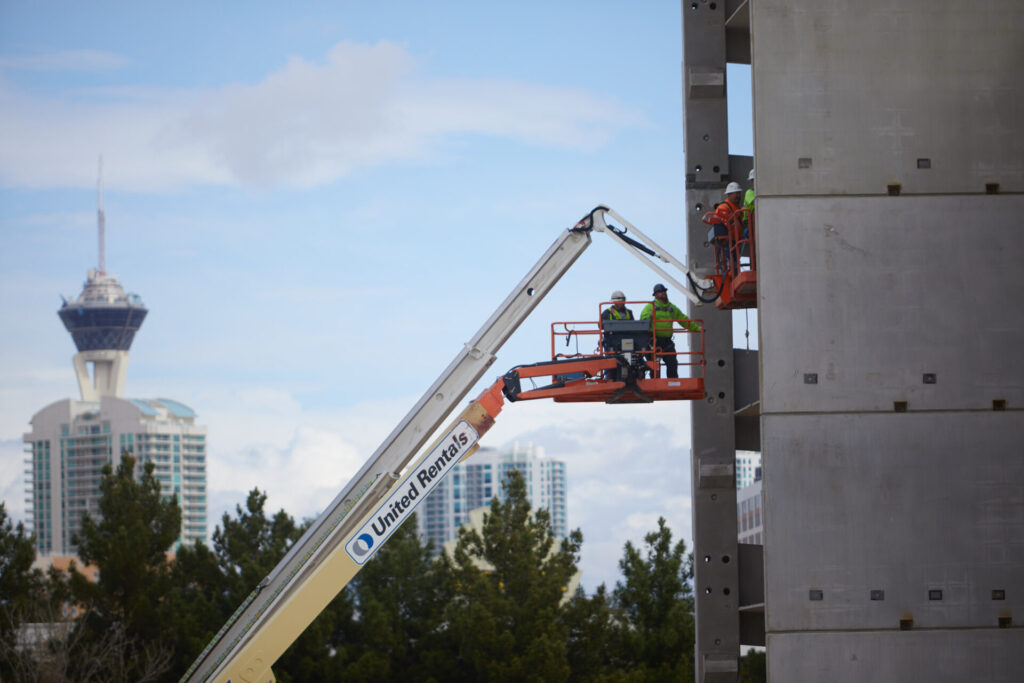The Future of Las Vegas is Looking Up

Remember when new apartments were one or two stories tall and office complexes were just one floor with beautiful courtyards coursing through them? Clearly those days are gone. The rising price of land and a limited supply of water and other resources have led to three story walk-up apartments and even a few high rises. It is also not unusual to find that spacious single story business complexes are now multi-story tilt ups. It is often the only way developers can make their projects pencil out. For decades, Las Vegas was just a small town that spread a little wider every time we looked. This is no longer the case, as more and more, development is going up!
What do all these changes mean for the construction industry? Imagine multi-story tilt ups where single-story office complexes used to be, and ten story high rises where tilt ups may have been expected. Everything will get taller, and the resort corridor will no longer be the lone portion of the valley with twenty to forty story buildings.
An influx of design and construction firms may be the first thing we notice. While there are existing Las Vegas companies with enough history and experience in high rise construction to design and build a twenty-story high rise. Are there enough? The level of polish and organization in architecture will only grow with the height of the building. Of course, it never hurts to bring in a big, outside name to add some marquee value to the project. Seasoned project managers with experience and a great breadth of knowledge will also come at a premium, as will other professionals requiring boots on the ground.
Since the pandemic many professionals have been able to work remotely. This could become a benefit for developers. Yet others, including geotechnical engineers and construction inspectors will need to remain near the job site. These locally-based workforces will always be in need because of the locality of the subsurface conditions and how they relate to the construction process.
More analysis will be needed during the design process. A lot of concrete will be poured in a relatively short period of time into footings and forms. Structural engineers will integrate state of the art methods for lowering the temperature of mass concrete foundations during hydration and curing of 8-ft. footings. Material testers, like those found at GES, will perform early concrete compressive strength tests, and use moisture meters to monitor the temperature and curing in real time to keep the project moving forward. Materials will need to be sourced early and staged nearby. A concrete shortage, similar to what is being experienced now, or a delayed steel delivery could cripple a project. Construction management companies will need to focus on logistics like never before.
An already strapped talent pool gets even smaller. With fewer workers in the construction trades than ever before, project management will need to increase its efficiency. In some fields, including ours, seasoned inspectors will need to be on site all day, every day, rather than conduct periodic inspections over the course of a week. Safety, already a hallmark of our company culture, will leap in importance. Most local labor pools are accustomed to working tens of feet off the ground. Now they will work hundreds of feet in the air where one slip could be fatal. Any fall is sure to make the news, and reputable companies will work even more diligently to ensure their employees are getting home safely to their families at the end of each shift.
For our part, GES inspectors will spend dramatically more time in the field, requiring more inspectors to meet demand. Where some tilt-ups may only require periodic observations. Taller structures will demand our team to remain on the jobsite much longer, likely continuously through each work shift.
New ways to build will also present themselves. As the world goes green and looks for methods to use renewable resources, we could see more buildings comprised of concrete and… timber. In the United States, the tallest wood building of its kind, a 25-story apartment building, was just completed. Wood may be the construction industry’s most renewable resource. In addition to helping to protect our environment, onsite construction time drops when wooden glulam beams are built to suit at the mill, tested, and delivered “just in time” before installation.
Materials and processes will evolve. Design teams, government entities and contractors, will learn to navigate paths to safe, comfortable, and economical projects built primarily of wood or other new materials. Already advances are being made in firestopping. Burn tests are being performed on massive beams ensuring a fire on the first floor of a building will not bring the entire tower tumbling down.
GES is planning for the future. Our special inspectors are certified and have the knowledge required to perform testing and inspections on high rise construction. We are continually working toward training the next class of special inspectors. And our company is International Accreditation Service (IAS) certified, with accreditation, a key component to perform special inspections within the City of Las Vegas and are certified with the Clark County Building Department to perform QAA inspections in Clark County. In twenty years, when the Las Vegas skyline is no longer a skinny row of hotels, we can look out and be proud of what we’ve built together. Your team and ours will have been part of reshaping the valley as Las Vegas expands… vertically.

